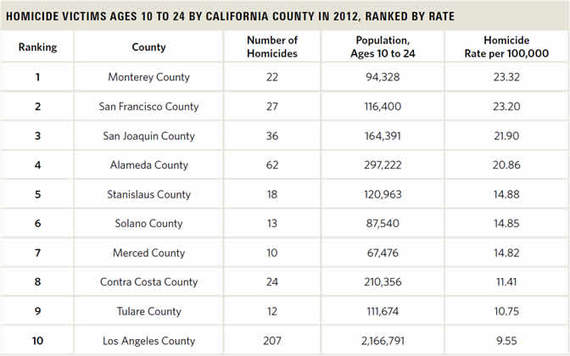
Homicide is the second-leading cause of death for Californians ages 10 to 24. And in a new, comprehensive study, we found that guns are nearly always the weapon of choice to murder California's youth.
Recently, my organization, the Violence Policy Center, released the fourth edition of our annual study Lost Youth, which takes a comprehensive look at youth homicides in California. In addition to a detailed, county-by-county analysis of homicides involving victims ages 10 to 24, we also interviewed community groups in Northern and Southern California that are pointing the way to effective solutions.
Our study found that 646 Californians ages 10 to 24 were homicide victims in 2012, the most recent year for which data was available at the time of research. The per capita homicide rate for this age group in California that year was 8.06 per 100,000.
These statistics, based on unpublished data from the California Department of Justice Supplementary Homicide Report, are even more disturbing when broken down by race and ethnicity for this age group. The homicide victimization rate for black youth in California was more than 17 times higher than the homicide victimization rate for white youth. The homicide victimization rate for Hispanic youth was more than three times higher than the rate for white victims.
Our study also ranked California's counties on their youth homicide victimization rates. Monterey County ranked the highest in 2012 with a rate of 23.32 per 100,000, followed by San Francisco County, San Joaquin County, Alameda County, and Stanislaus County. (See below for a chart of the counties with the 10 highest rates.)
Statewide, the vast majority of the 646 homicide victims (89 percent) were male. When the relationship between the victim and the offender could be identified, 47 percent of victims were killed by a stranger. And when the circumstances could be identified, most of the homicides (78 percent) were not related to the commission of another felony. Of these, 65 percent were identified as gang-related.
In short, we found that for far too many California youth, the trauma resulting from violence -- all too often gun violence -- is a pervasive part of daily life. We owe it to our youth to respond to this public health crisis with timely, effective solutions.
What can be done? First, it should be a priority to prevent youth and young adults from accessing firearms -- particularly handguns, which accounted for 70 percent of all gun homicides in this age group. It should be kept in mind that youth under age 21 cannot legally purchase a handgun, and it is generally illegal for anyone under 18 to possess a handgun. For this reason, it is highly important that we identify the sources of these weapons, as well as their make, model, and caliber.
However, preventing access to guns is only one piece. Our report took a close look at local strategies that have worked -- and what hasn't worked -- to help bring the violence under control.
In recent decades, a series of misguided laws and policies adopted a "suppression" approach to reducing youth violence. This included making it easier to try youth as adults and using increased jail time and other punitive sanctions. Yet mounting evidence shows this approach has been costly and counterproductive. It is not fiscally responsible, nor is it sound policy practice, for communities to attempt to arrest their way out of youth violence.
Instead, the latest research shows that prevention, intervention, and community engagement are the most effective paths to reducing violence among youth and young adults. In California, many local organizations have established successful programs that both improve the lives of youth and benefit entire communities.
As part of our study, we conducted extensive interviews with community groups that show how these strategies can work. The Coalition for Responsible Community Development (CRCD) is a neighborhood-based community development corporation in the Vernon-Central neighborhood of South Los Angeles. The group works in partnership with businesses, nonprofits, and community leaders to help revitalize the neighborhood and create opportunities for its residents.
Also in Los Angeles, the group InsideOUT Writers holds classes in juvenile detention facilities and teaches creative writing to students while providing other forms of support. In Oakland, Youth UpRising is a "neighborhood hub" that offers services and programs to young people.
As Youth UpRising President and CEO Olis Simmons told us: "We have to make long-term investments in this world. As we begin to make progress, we have to begin to expand out the notion of what prevents violence ... It's focusing on the crisis at hand while building out structures that truly prevent violence, like quality early education, that ultimately will get us to where we're going, which is safe communities."
These community-based programs are teaching lessons that can, and should, be learned across the nation. As one community leader, director Jose Arreola of the Community Alliance for Safety and Peace, wrote in response to our report: "We have and have had our work cut out for us. Knowledge is power, may we all use this information to continue to work smarter, not just harder."

